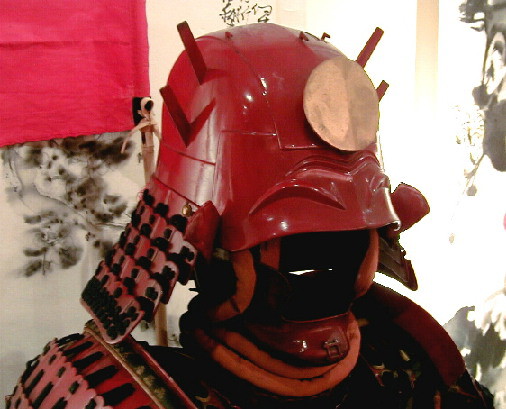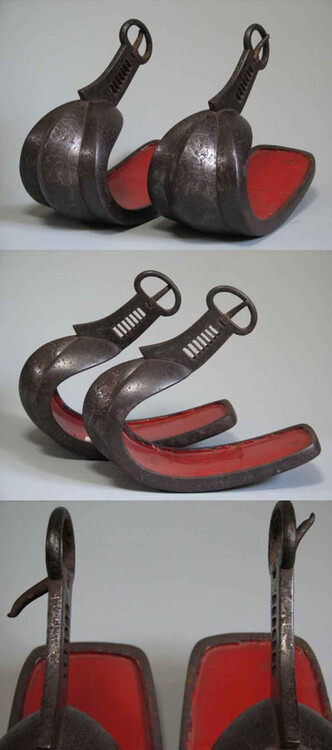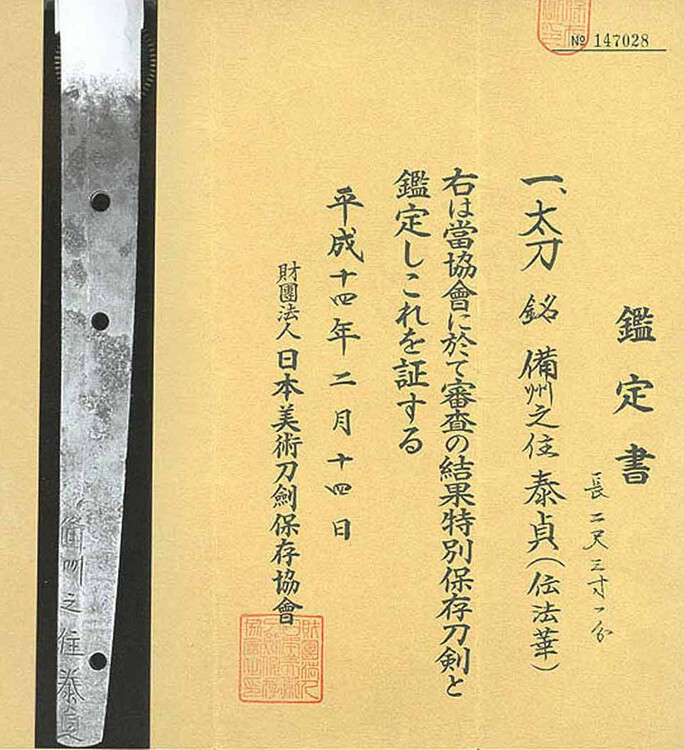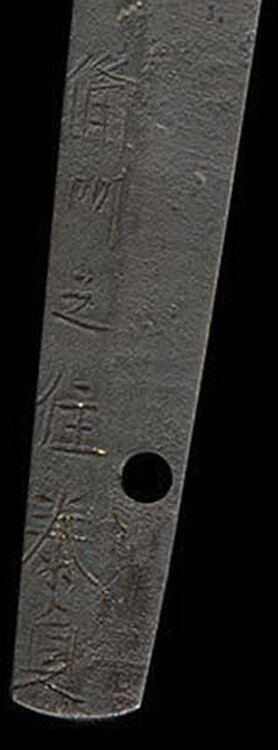-
Posts
341 -
Joined
-
Last visited
-
Days Won
2
Everything posted by leo
-
Hi, In the 1st column before the seals it says Gen roku goro, which means NTHK thinks its Genroku era(1688) The state of the nakago is pretty clear from the oshigata, it seems ubu with 1 peg hole signed Noshu ju Kaneyoshi. Looks like a nice Shinto blade made by one of the numerous Mino Kaneyoshis who worked around that time(maybe KAN 3035?) Regards, Martin
-
Dear Eugene, Jaques is right, in the case of the Yoshimichis there is no Tango, but only Tanba, even though the Kanji looks alike. Also all of them I have seen, up to the last generation, signed the Tan in a similar style as the 1st Yoshimichi like a billowing sail(Hokake Tanba). So gimei seems likely! Regards, Martin
-
Hi, here is a Muramasa tanto with Tokubetsu Kicho Paper. Was offered 2 years ago together with nice aikuchi koshirae for about 15.000,-USD. Was supposed to be Muramasa II from Taei Era. Regards, Martin
-
Hello, Erich, this is a Mishina-school smith: Munetsugu, 1748, Settsu, Mishina Tajima (no) Kami Fujiwara Munetsugu 三品 但馬守 藤原宗次. Student of Mishina Kanemichi. His hada was mainly Ayasugi. Very easy information about Mishina school here: http://www.nihontocraft.com/Mishina.html Regards, Martin
-

Not Nihonto but it is Samurai
leo replied to jason_mazzy's topic in Auctions and Online Sales or Sellers
Hi, Eric! Thank you for the link. I am seriously considering this offer. Regards, Martin -
If it was a clear attribution to Kinju, Jean, it would be a true catch. As far as I can see it is only Kaneshige school which can also mean a student. Then I prefer a clear attribution to Kaneyuki(eldest son of Kinju) by Juyo paper for the same price(fetched 1.880.000,-JPY). Very pretty blade including koshirae: http://www.l-wise.co.jp/super-jsa/aucti ... l&num=6612 Martin
-

Do you like these fuchi koshirae?
leo replied to jason_mazzy's topic in Auctions and Online Sales or Sellers
Dear Jason, do not let youself be confused too much. This set of fuchikashira is made of sentoku(patinated brass) and the workmanship is of good quality. Off course it is late Edo, but this is no reason for disqualification. With a matching tsuba it would look pretty on any tanto or wakizashi. The price was very reasonable. Please note that a fuchi size of 3,6cm is only suitable for wakizashi or tanto. For a katana you would need probably 3,9cm or larger. Regards, Martin -

Not Nihonto but it is Samurai
leo replied to jason_mazzy's topic in Auctions and Online Sales or Sellers
Thanks for the video, Lorenzo. I did not understand much, but the film made a lot of sense. Fascinating dragon mask, Eric. Now I need just a place which sells stuffed horses --off course at a bargain price(shipping included!) Martin -

Not Nihonto but it is Samurai
leo replied to jason_mazzy's topic in Auctions and Online Sales or Sellers
Nice set, Eric, i am getting nervous now. Would match my Ii-Armour. Now I need just the matching leathers, the horse,........and the matching house to display it!!! :D :D Martin -

Not Nihonto but it is Samurai
leo replied to jason_mazzy's topic in Auctions and Online Sales or Sellers
Some pictures of my saddle, Eric. Except for the side protectors it is complete including chest and stand. I am still lookig for matching protectors in green and gold leather. The kura is late Edo, the abumi are early Edo, maybe earlier. They carry the kiri mon and a signature which I suppose, is "Nariyuki Saku", eberything originally inlaid with silver(ginzogan), most of it gone now. Generally they show a lot of wear. Here they come: -

Not Nihonto but it is Samurai
leo replied to jason_mazzy's topic in Auctions and Online Sales or Sellers
There is a nice Edo kura with complete leathers in my collection, so I checked on this topic a while ago. Design and construction of the "kura" remained literally unchanged for almost 900 years up to this day. Therefore the suggestion that saddlemakers suddenly ceased to make good saddles and the samurai horsefighter class completely went into retirement just because it happened to be Edo time is off course nonsense. Here are some bits about the "kura": "The horse and the technique of fighting on horseback(bajutsu) was brought to Japan by the mongols. By the 6th century horses were widely used. The typical "kura" type of saddle probably did not develop before the Heian-Period in the 8th century. It gradually developed to its final shape and basically did not change anymore from the Kamakura-Period until modern times(!). It was now perfectly adapted to the highly specialised art of horseback combat as practised by the samurai nobility. These techniques, usually fighting with bow and arrow, polearms or with the long sword(tachi), required extreme , even artistic skill. Only samurai of the highest ranks were allowed and could afford to use a horse in combat. The training of the a samurai combat horse was expensive, complicated and took a long time. The saddle frame consisted of 4 parts: pommel, cantle, a 2 piece saddle tree holding both together, being the seat at the same time. The 4 parts were connected with special cords supplying a limited flexibility. The saddle was made from hardwood and had a weatherproof layer of laquer. The visible outer parts were decorated in varous styles typical for Japanese laquerwork. Seat cushion as well as leathers were usually made from laquered leather. The saddle was used with a saddle blanket from woven textiles dyed or stitched with with various patterns. The stirrups(abumi) in their distinctive shoelike shape as the saddles did not change anymore after the 13th century. They were made from iron and were either laquered or decorated with inlays of brass, silver or gold." Martin -
Dear Jamie, I wanted you to check on the genuine signatures to find out by yourself whether it is gimei or not, but apparently you misunderstood. The first kanji already shows the significant difference. Off course Brian is right, there is no chance it is a genuine Suishinshi Masahide. Greetings, Martin
-

THE PRESENTATION OF A SAMURAI SWORD
leo replied to Stephen's topic in General Nihonto Related Discussion
An interesting letter. What is really strange and makes me a little thoughtful though, is the fact that the identity of the stolen sword is not revealed. Nobody can convince me that the sword was presented to the Library without documentation. As a long time collector and dealer I know by personal experience, how valuable for successful recovery it can prove, if the sword`s identity is made public. If somebody is not willing to do it, there must be a very special reason. Even if the sword is of immense value, some time has passed since 1977 and eventually time will come for it to find its way to another collection or into commerce. Off course I might be mistaken or the sword is a mumei blade of no importance. Then it would be difficult to trace it. Martin -

THE PRESENTATION OF A SAMURAI SWORD
leo replied to Stephen's topic in General Nihonto Related Discussion
An entertaining and touching story, Stephen, thank you. Peaceful individuals toil hard to establish relationships between nations, but land and power hungry politicians eventually spoil it all. That is the sad story behind it and it goes on all over the world to this very day! Something to think about. Regards to all, Martin -
Hi, this view is better for reading the mei. If you simply google SUISHINSHI MASAHIDE, you will find plenty of genuine mei samples which will show you the difference between this mei and the real ones. Date and filemarks match, though. Regards, martin
-
Dear Clive! A while ago I also checked into the matter because I purchased a pretty Katana blade (70cm nagasa, o-suriage, mumei), which was supposed to be a shodai Shigetaka blade. I enclosed the paper. Maybe someone can translate the attribution? Like myself you have probably found hundreds of links which produced little information except this: The shodai is said to have been a student of Kanenori with whom he moved from Mino to Echizen. There is rumour that he also studied under Yasutsugu. The blades of the nidai resemble rather Yasutsugu´s works. Some say that many swordsmiths, among them Shigetaka, moved to Echizen in the 1600s, because Tokugawa Ieyasu´s son Hideyasu was exiled to Echizen by his father around that time and some of the better smiths were retained by him. But there is no prove of this. Another smith of the Echizen den, Harima Daijo Shigetada, moved from Echizen to Owari and served the Owari Tokugawa clan. Very little information so far. If you find out more, please let me know! Regards, Martin
-
Hi Justin, do not worry too much about color codes. The color design of koshirae always varied with the fashion of time and the taste of the owner. Like always there were practical as well as monetary reasons to choose the ito. A lighter colored material had to be replaced more often than a darker one and there were "business" koshirae as well as "parade" koshirae for the same blade. The only formal restriction I found, which was edicted in the 17th century by the Tokugawa shogunate, was in an article by Guido Schiller "A brief History of the Development of the Koshirae": "......Samurai at the castle in Edo wore the Banzashi daisho, "duty attire". "Same" had to be white, the saya black lacquered and with horn fittings. The kojiri of the katana was flat, and that of the wakizashi rounded. The kashira had to be horn, with the black tsukamaki crossed over it (kakemaki). The fuchi and midokoromono ("things of the three places": menuki, kogai and kozuka) had to be shakudo-nanako (fish-roe pattern) with the only decoration being the family mon (crest). The tsuba was polished shakudo without any decoration. However, this was not always strictly enforced, and kanagu with shishi (lion dogs), dragons or floral motifs were tolerated...." This "black on black" design was rather locally enforced, though. Personally I like the simple elegant combination of a shiny black laquer saya(roiro) and a black silk tsukaito on white same best. Whatever color you choose, make sure that the execution of the restoration is faultless! A badly wrapped tsuka will make the whole sword look bad! Good luck, Martin
-
Dear Chris, I am not a superexpert, but I would like to release some ideas to discuss. There are, very generally spoken, a few typical characteristics which you find more often in Yamato blades than in others, as far as I know: High shinogi ridge Kaen boshi(hataraki flames) Masame(Tegai) The question of the nakago is not clear. As there is only 1 hole, there are 2 options: 1. Ubu (with the yasurime and the rather short nagasa Koto is very unlikely) 2. O-suriage (then it might be Koto, but it could also be a shortened shinto nodachi) But as most of us like to say: Off course I can be mistaken! Best regards, Martin S.
-
Hi, Dirk, as you already said, absence of kiku and the signature make it, in my opinion, clear it´s an Osaka Tanba (wakizashi?). Anyway this looks like a really pretty blade worthwhile polishing I love the mishina blades myself and have 3 Yoshimichis in my collection(katana, wakizashi, tanto, two 2nd and one 3rd gen.), but all are Kyo-Tanbas, so I cannot compare the signature to get an idea about the generation. But if the sudare ba style development is similar that of the Kyo-Tanbas, you might say this: The more flamboyant and pretentious the sudare ba is, the later the generation. Off course there are always exceptions. If I find something more precise, I´ll let you know. Regards, Martin
-
Hi, John, Thank you for this interesting contribution! Sho-shin´s "family trees" are very helpful. I have also used them on several occcasions. The Hokke school history and the warrior-monk/swordsmith Ichijo is really worth a study as is the history of the Nichiren(Lotus)-sect. During my search for Yasusada I have read some fascinating articles about these warrior monks who apparently were busy until the late Edo period and whose support was always coveted by the various political factions when armed conflicts were imminent. The kanji combination for this Yasusada is, as you say, unusual. If the the TH Paper was not genuine beyond doubt I would think there is something wrong. On the other hand it might be an interesting new find among the Hokke school smiths and some day we can supplement Sho-shins tree ! Still, if anybody has news on this smith, please let me know. All the best, Martin S
-
Dear Koichi san! Thanks for the fast reply! That´s exactly where I bought it! Good research! Apparently then I misunderstood the info which was given to me. I should learn to read Japanese soon! Also I drew the wrong conclusion probably because the announced age of the blade falls into about the same period as the working period of HOKKE ICHIJO (1350-1398) If even you could not find anything about the smith, chances are getting slimmer! Many thanks, Martin S
-
Dear Members! Even though I have been collecting and dealing Nihonto for a few decades myself, I now need some professional help. A while ago I acquired a good tachi from Japan. I resold it later to a fellow collector who loves it, so it is not up for sale! I included pictures of blade, nakago, mei and Tokubetsu Hozon paper. It is signed BISHU KORE JU YASUSADA 備州之住泰貞 and the NBTHK attributed it to HOKKE 法華 school. The Japanese seller told me, this smith was a student of HOKKE ICHIJO, an artisan who is not unknown to me. Accordingly the blade should be, I suppose, from the late Nanbokucho to early Oei-period. I tried my best to trace this particular YASUSADA, but without success (shame). Now, as I still owe some profund information to my collector friend, I hope that someone among you who owns more Japanese literature than I do, can find out more about this smith. Many thanks, Martin S
-
Hi, all, nice cane sword for sale here with a rather long blade which does not look that bad! http://www.l-wise.co.jp/super-jsa/aucti ... ode=detail Regards, Martin
-
Hi, George, this looks like a nice little wakizashi with an ubu nakago. The nakago and mei really look good but rather like 1800 than 1532. On the other hand, why should someody bother to fake the signature of an rather unimportant smith? Imho his leaves basically 2 possibilities: 1. Some dedicated follower of Heianjo Nobuyoshi, maybe a descendant, had this mei chiselled at a later time in memory of his ancestor. 2. The nakago has indeed been preserved to it´s present state by leaving it in the tsuka for a long long time, keeping it in a dry place at the same time. Unusual but not impossible, either. All the best, Martin S
-
Dear Brian, I guess you are right if you compare the shape of such a sword with the elegance of a katana of traditional design. Let´s rather take it as what it is: a curiosity, but still a weapon. For purists, it could be remounted in a shirasaya anytime. By the way, I think that it was never really used as a sword. While the tanto size might be practical for piercing an chainmail, the tsuka of this long yari blade would not give enough leverage to use it effectively for thrusts. My guess is that it might have been a gift to a buddhist shrine, as it closely resembles the typical buddhist symbol "ken". Regards, Martin S












